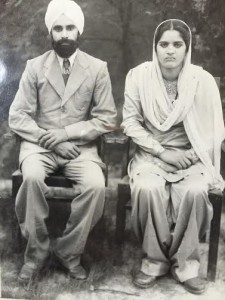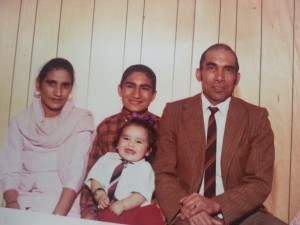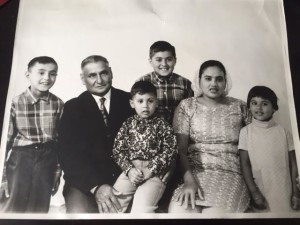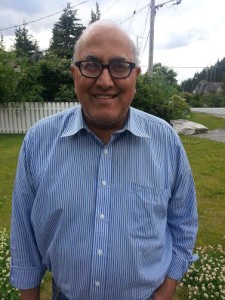
By GAGANDEEP GHUMAN
Published: July 10, 2016
Published: July 10, 2016
THE PASSPORT pictures of Resham Singh Sangha document a singular moment of transformation: You have to look hard to square the man in the old Indian passport with the one in the Canadian one. Shorn of his turban and beard, the besuited man in the Canadian passport wears a faint smile and bears little resemblance to the young Sikh gentleman in the Indian passport. The pictures are an effective trope to explain how men like Sangha left a comfortable world behind to venture audaciously into an unknown alien world driven by ambition and adventure and a desire to provide for the family left behind. Resham Singh Sangha was one of the early pioneers who found their way and put their roots down in Squamish in the 60s, along with Gurdev Singh Biln, Mahinder Singh Mahnger, Resham Singh Aujla, Mukund Lal Sharma, Tersem S. Sahota, Resham S. Lalli, Harbhajan S. Grewal, Amar S. Biln, Naranjan S. Lasher and many others who came to Squamish to find work at the local lumber mills and then settled down to raise a family.
Resham Singh Sangha shared many stories with his son-in-law Kartar Singh Badyal, who takes a keen interest in the early pioneer history of Sikhs. Badyal said Sangha often told him stories of his survival in Italy, where he fought for the British Indian Army during the Second World War. He survived the war and followed his father Dalel Singh Sangha and his uncles Rakha and Rajmal Sangha to Canada in the 60s. There were 15 people who came in 1906 before the Komagatu Maru incident in a ship called Empress of Japan, all from the village of Sakruli in Hoshirapur, says Badyal. 
Resham first went to live with one of his uncles in Lake Cowichan and then made his way to Squamish in the late 60s to work at the mill. He got the hair cut at the suggestion of his uncle in an effort to fit in well, said his daughter, Gurbax, who lives in the first home her father bought in the 1970s in downtown Squamish. Resham Sangha could easily be the protagonist of most stories of East Indian pioneers. While the early Sikhs pioneers have been recorded in BC since 1904, restrictive immigration policies meant they couldn’t bring their families, which turned into a tradition of sorts. Most men like Sangha were sponsored by uncles and other relatives but came alone and led a nomadic life, moving from one place to another as they worked at sawmills across the province.
“They often came solo and then they would spend four-five years here working at mills in Lac La Hache, Mackenzie, and other northern towns and then go back to India, stay there for a few years and then come back again to Canada,” Badyal says.
This is what Lashkar Singh Aujla did, whose life story follows the same arc as that of other Sikh pioneers who came to Canada seeking opportunities. Aujla was sponsored by his uncle. He recalls trips up north working for lumber mills in Prince Rupert. With a child-like delight, Aujla remembers those trips he took with his young friends.
“There were four or five of us and we drove up to Prince Rupert and found a job there at the mill and worked all day there and slept in rooms the owner had for us in the mill,” Aujla recalls. Aujla says the men would often hire someone to cook food and pool in resources to pay for the cost of the food and other things.
Aujla worked on the green chain, sorting and pulling lumber from the chain and stacking it. It was eight hours of hard manual labour but with limited education and lack of language skills, it was the job where a lot of men started. But mill work was stable with a good pay cheque and a strong East Indian network meant it was relatively easy to find work. Aujla came back to Vancouver after an attempt to create a workplace union went awry. Someone informed him that a new mill in Squamish was looking for workers. He came back to Vancouver and started commuting to Squamish to work at the mill as it was a tough place to find housing. Aujla was married when he came to Canada and the only way to communicate, he recalls, were letters that could easily take a month to reach back home. He didn’t go home for the first 10 years he was in Canada but when he did, he ended up staying for a good five years. It’s a life story shared by many Sikh men — they came here at the invitation of their families and went from one town to another working in the mills till they finally found a place to settle down.
For Kundan Singh Sangha, that place was Squamish. He came to Canada in the 1961 at the invitation of his family and went to Port Alberni to work at the lumber mill, where he worked on the green machine. “For nearly 10 years he lived alone and life was all about work, work and more work so he could send money back to his family in India,” says his son, Harjinder Sangha.
Harjinder says his father came to Squamish at the invitation of Gurdev Singh Biln and shared a house with other single men until he bought his first home for $7,000 on Fourth Ave. Harjinder says men like his father faced seemingly insurmountable challenges but they overcame them with sheer hard work and desire to succeed and provide for family back home. 
“You are away from your family, in a new country and you don’t know the language and then there is discrimination and racial barriers you have to overcome while you are working very hard to provide for your family and build a life in a new country,” Harjinder says, adding that first and second generation often takes many things for granted. “It was a hard life and that is something the first and second generation need to reflect on… the challenges and the sacrifices those men made for their families,” he says.
Former Squamish councillor Paul Lalli went back to India four years ago on a personal pilgrimage — to see the place where his parents grew up. The visit was a reminder, he says, of the many sacrifices the first generation Indo-Canadians made to ensure their offspring get a chance at a better life.
“It was very humbling for me to go and see the place where my parents lived before they took the decision to come to Canada,” he says.
Lalli’s parents, Resham Singh Lalli and Darhsan Kaur Lalli came to Canada in the early 60s and settled in Victoria, but later moved to Squamish when his father got a job working as a miner at the Britannia Mine and later in the Squamish mill. While language was a barrier for many East Indians, it wasn’t the case with Resham Singh Lalli as he could converse in English and helped many with writing letters or filling out forms. Lalli said his father was an open-minded person who liked to interact with people outside his community.
“He wanted us to integrate well in the community and he encouraged us to be part of Halloween, Christmas and all the other things that make us Canadian and I remember I used to go to Sunday school in the Garibaldi Highlands,” he said.
Paul Lalli was the first South Asian person in Squamish to be elected as a councillor and that wouldn’t have been possible if his parents had not underscored the importance of being integrated in their adopted country, he says. “They believed in giving back and immersing yourself in the community and yet at the same time being proud of your culture and heritage. All of that prepared me to take a leadership role in the community and I’m really grateful to them for those values they instilled,” he says.
Jessie Bir says she often tells her kids they owe their luck of being Canadian to their grandparents, Mahinder Singh Mahnger and Gian Kaur. Bir says she is amazed at how the early immigrants like her parents established themselves in Canada with sheer grit and gumption. Mahinder and Gian raised their kids, Terry, Ambi, Bob and Jessie, in Squamish and established close friendships with many families that still live on. Jessie remembers her parents with pride. 
“My dad was very hard-working and we were his priority. My parents never let us feel the stress of whatever struggle they were going through in life,” Bir says. Her father never learned to drive, couldn’t speak English and lacked formal education but somehow made a decent life in Canada with hard work and determination to succeed. She says that with lack of formal education, skills, language and without modern means of communicating with family back home, pioneers often depended on each other for emotional and social support. It was a far more well-knit and interdependent community than it is now. Jessie says she sees herself as a proud Canadian and has never been to India but does value her culture and heritage. Her sons, Jared, Taran and Keenan, are often reminded, she says, of the sacrifices their grandparents made. “They allowed us to have this beautiful life here in Canada and we are very grateful to them for that,” she said.
Harvey Grewal was all of 21 when he first came to Canada and started working in lumber mills in Port Alberni as a lumber puller, while also working towards completing high school. The pay, he says, was good but the job was tough and required a lot of physical effort.
“They paid quite well for the time and there were a lot of East Indian people around. There weren’t a lot of jobs to go around either,” he says, explaining why a number of east Indians in the 60s and 70s started their lives working in the mills. He later worked at the mill in Tahsis but a visit to Squamish to meet his friends brought him into contact with the local mill manager, who offered him a job in Squamish.
“Tahsis was very isolated and I came down here and then bought a house and later when my wife came from India, we started living here,” he says.
Raj Sherman, now an emergency room doctor and a former leader of the Alberta Liberal party, says his parents instilled in him values of dedication and hard work. His grandfather, Bal Mukund Sridhar, came to Canada in 1906, got a sawmill degree and worked as a superintendent for the lumber mills owned by the Mayo family on Vancouver Island. His father, Kirthi Kumar Sherman, came to Squamish in 1965 and worked at the mill before he brought over his family from India and settled in Valleycliffe. Raj Sherman says the family is now living the Canadian dream because of the values his parents instilled in him and his siblings but it wasn’t an easy journey for his parents. Once, he recalls, his dad came back from the mill with bloodied fingers from a workplace injury — and he was back at work after just a few hours of rest at home.
“He worked overtime and double shifts and we didn’t really see him a lot but he was a jovial man and I can’t remember a time when he complained about his job or his life,” he says. But his parents did encourage him and siblings to work hard towards getting an education.
“Our parents instilled in us the value of education. My father was a teacher when he left India in 1965, two months after my birth. I met him for the first time in 1972. My mother was attending college (with three kids) before arriving in Canada in 1972. In Squamish, dad worked long hours in the mill and mom took us kids to the Fraser Valley berry-picking farms every summer for our first five years in Canada.She then became a seamstress in Mrs. Sweeney’s factory. It is my understanding that Edmonton Oiler’s uniforms from the Gretzky era were manufactured in Squamish. When Whistler got busy, mom worked in the hotels. Watching my educated parents struggle instilled in me the value of a good education,” he says.
Gurdev Singh Biln came to Squamish in 1963 and worked in the mill as a lumber grader until his retirement in 1988. His son Singh Biln says pioneer Sikhs faced many challenges as they tried to make a new life in Canada and in BC. They were barred from voting, housing was sometimes scarce, and it was at times difficult to rent suites because of the strong, peculiar smell of Indian food. And then there was the weather and other customs. Singh Biln recalls that when he first came from India, the kids had all wool clothing and didn’t wear jeans and were dressed funny. “We had no snow boots and first time we saw snow, it looked like blanket of wool so we got a shock when we went out in it,” he says. Social interaction with the mainstream community was limited as language was a barrier for many people, although that started to change in the 70s and 80s. Until the 70s, most South Asians wore western dress and fit in quite well as the numbers were few except in larger cities and towns, Biln says.
“I recall that many of our white friends being invited for Indian dinner as there were few Indian restaurants around and no Indian shops to buy spices. It was only in the 80s that Indian restaurants and shops came to most communities,” he says. Singh Biln’s father was the first one to purchase a house in Squamish and it became the centre of activity as housing was quite scarce and Biln house was rented to many of those who came to work in the mills.
“We always had two or three cousins staying with us until they found their own place during that first year. Over the next couple of years, our father bought a couple of houses downtown and rented them to single South Asians so they were de facto ‘Hindu bunkhouses’. One was at corner of 5th Ave and Victoria which has now been fully renovated and another was on Buckley near the high school at Wilson Crescent but now replaced with commercial buildings. There was another one on south end of 4th Ave next to old Catholic Church. These places had five or six guys living in them and were always the centre of socializing for South Asian men. Hindi film music would be playing all the time and there would be long card games on weekends. Some of the men were great cooks and I still can taste the flavourful curries,” Biln recalls. 
While pioneer Sikhs first started to come in Squamish in the 1960s and 70s, it’s believed that some of these new immigrants also worked in the Squamish area in the woods or at the local mills in the 1910’s and ‘20’s. These men generally kept to themselves and lived in barracks-type accommodation in the downtown area next to Logger’s Lane. According to Singh Biln, most of these men worked for wages doing unskilled labouring work but there are records of at least one enterprise. Jaswant S. Mahal and Assa S. Johal, Sr. established a shingle mill around Alta Lake in 1926. They had purchased 300 acres of timber through a broker and operated the mill until 1929 when they sold it to some Japanese. Apparently there was also a ‘Hindu’ mill in Squamish at this time. Other Sikhs also left the valley in the late Twenties as jobs became scarce, and there are no records of any South Asians in the Squamish area for the next three decades. It wasn’t until the 60s that the Sikhs first started coming to Squamish with the first South Asian family of Gurdev Singh Biln, his wife Swaran Kaur, children Jaswnt Kaur, Jaswant Singh, Kalwant Kaur and Kalwant Singh and then soon after joined by Mohinder S. Mahnger’s family, who had worked for Canadian Colleries on the Island, and came here with his wife Gian Kaur and young children.
Later, the community grew as the friends and families of the pioneers continued to come to Squamish with Kundan S. Sangha, Kirthi Kumar Sherman, Sarwan S. Cheema, Gurmail S. Grewal, and Bhai S. Bir putting their roots down in Squamish. In the 80s, when automation led to shortage of jobs in the mills, immigrant and first-generation Sikhs ventured into commercial and retail businesses. These included Rajinder S. Khalon (True Value Hardware), Kalwant S. (Bill) Biln (Squamish Realty), Parmjit S. Johal (IDA Pharmacy), Surjeet S. Biln (99 Transport), Avtar S. Gidda (Gold Fabrics), Paul S. Lalli (Sea-to-Sky Hotel), Terry S. Mahnger (Eagle Run Petrocan), Money Kissun (Squamish Tire), Tersem S. Jain (Jain Construction), and Avtar S. Giri (Squamish Driving School). Since the 90s, many Sikhs families have established their own businesses or worked in Whistler and Vancouver.

